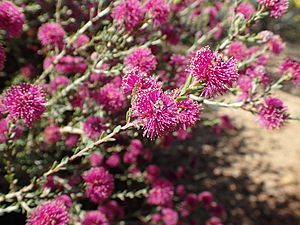Phymatocarpus maxwellii facts for kids
Quick facts for kids Phymatocarpus maxwellii |
|
|---|---|
 |
|
| Phymatocarpus maxwellii growing in Kings Park, Perth | |
| Scientific classification | |
| Genus: |
Phymatocarpus
|
| Species: |
maxwellii
|
| Synonyms | |
|
Melaleuca maxwellii (F.Muell.) Craven & R.D.Edwards |
|
Phymatocarpus maxwellii is a special plant that belongs to the myrtle family, called Myrtaceae. You can only find it growing naturally in the south-west part of Western Australia. This means it is endemic to that area.
This plant looks a lot like many small types of Melaleuca plants. The main difference is how its anthers (the part of a flower that holds pollen) are attached to the stamens (the male parts of a flower). In Phymatocarpus, the anthers are attached at their bottom and open up at the top to release pollen. It's a shrub that often gets covered in many small, pretty pink to purple flowers. These flowers can stay on the plant for several weeks, usually in October.
What it Looks Like
Phymatocarpus maxwellii is a shrub that can grow upright or spread out. It sometimes reaches about 2.5 metres (8 feet) tall and wide.
Its leaves are shaped like wide eggs and are about 4 to 6 millimetres (0.16 to 0.24 inches) long. They are often curved and feel stiff, but they are not prickly.
The flowers are pink to purple. They grow in tight, round clusters that are about 10 millimetres (0.4 inches) across. These flower clusters are found at the ends of the branches. The branches keep growing even after the flowers bloom. Each flower has 5 sepals (small leaf-like parts that protect the bud), 5 petals, and 5 groups of stamens.
You can tell this plant apart from the other two types of Phymatocarpus because it does not have a ring of stamens joined at their bases. The other two species do have this ring.
The plant flowers from August to November. After flowering, it produces woody fruits called capsules. Each capsule is about 2.5 millimetres (0.1 inches) wide. These capsules grow in bumpy clusters on the outside.
How it Got its Name
The plant Phymatocarpus maxwellii was first officially described in 1875. This was done by a famous botanist named Ferdinand von Mueller. He wrote about it in his book called Fragmenta Phytographiae Australiae.
The second part of its name, maxwellii, was chosen to honour a plant collector named George Maxwell. He was the person who collected the very first sample of this plant that scientists used to describe it. This first sample is called the type specimen.
Where it Grows
You can find Phymatocarpus maxwellii growing in different areas of Western Australia. These areas include places between Mount Barker East and Israelite Bay. It grows in regions known as Coolgardie, Esperance Plains, and Mallee.
This plant can live in many different kinds of places. However, it mostly grows in sandy soil on flat, sandy areas called sandplains. It also likes low areas that get wet during the winter months.
Conservation Status
The government of Western Australia, through its Department of Parks and Wildlife, has looked at Phymatocarpus maxwellii. They have decided that this plant is "not threatened". This means it is not currently in danger of disappearing.


